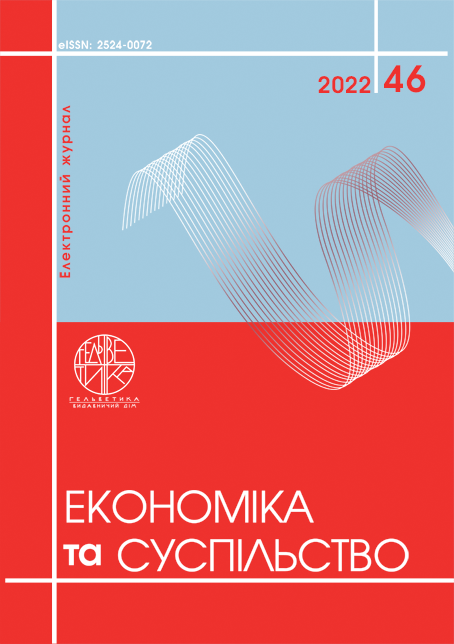HE ESSENCE AND CONTENT OF THE INTANGIBLE RESOURCES OF THE MODERN ENTERPRISE
Abstract
The article examines approaches to understanding the essence of enterprise resources and management activities to manage them. The meaning and relationships between the terms "resources", "resource provision", "resource potential" have been clarified. Intangible resources mainly include only those resources related to intellectual property and ensuring the protection of rights to it. This comes from the traditional approach used in accounting, but does not reflect the entire set of intangible resources that are at the disposal of a modern enterprise. This group of resources should include informational, intellectual and those related to the experience of the operation of the enterprise as a certain system (organizational and managerial). With such a division, we can talk about the availability of space and time resources in the enterprise, as in a certain system. It is also appropriate to include the company's work on lists of suppliers and buyers, which should be considered as a separate element of intangible resources, to intangible resources. We suggest that normative and methodological resources should also be considered intangible resources. This is, in particular, the availability of tools for regulating relationships within the enterprise, in the form of instructions, methodological guidelines that consolidate the universal knowledge of the organization, and also regulate methods of accumulating information as an important resource. Information resources are a coordinating and connecting element between all parts of the enterprise, as a system in the process of acquiring new knowledge, that is, in the process of learning the organization. Therefore, information or knowledge is a unit of information resources, and at the same time, information resources determine the possibilities of training and development of the organization, it is a tool of such training. In the resource approach, the company is required to proactively create, maintain and develop resources and competencies specific to it. The possibility of such development is determined by the availability of data on the past activity of the enterprise; information about the current state of affairs, about the abilities and skills of individual employees and the team as a whole, their knowledge and skills; information about the external environment, including forecasting of possible development options. Information resources should be considered as one of the elements of strategic resources in a modern organization.
References
Бердар М.М. Управління ресурсним забезпеченням підприємства у сучасних умовах. Інтелект ХХІ. 2020. № 1. С. 31–36.
Ващенок О.П. Сутність та класифікація ресурсів підприємств. Економіка. Менеджмент. Бізнес. 2019. № 2 (28). C. 104–108.
Верхоглядова Н.І., Письменна О.Б. Класифікація ресурсів та її значення для управління ресурсозбереженням. Інвестиції: практика та досвід. 2015. № 16. С. 27–31.
Мельник О.М. Ресурси підприємства: концептуальні аспекти системи управління в умовах стійкого розвитку. Науковий вісник Ужгородського національного університету. 2019. Вип. 23, ч. 2, C. 17–22.
Смолич Д.В. Тимошук І.В. Ресурсний потенціал підприємства: сутність, складові та модель управління в сучасних умовах господарювання. Економічний простір. 2020. № 153. С. 75–82.
Сівко Б.І., Сментина Н.В. Інноваційні підходи до управління ресурсами муніципального підприємства. Вчені записки ТНУ імені В. І. Вернадського. Економіка і управління. 2019. Том 30 (69), № 5. C. 69–73.
Ковтуненко Ю.В. Економічна сутність і класифікація інтелектуальних ресурсів підприємстві. Агросвіт. 2013. № 14. С. 51–53.
Кирилюк О.В. Інформаційні технології в управлінні асиметрією розвитку компанії. Вісник Хмельницького національного університету. Економічні науки. 2019. № 3. C. 95–98.
Мєшкова В.С. Особливості управління стратегічними ресурсами підприємства. Глобальні та національні проблеми економіки. 2014. Вип. 2. С. 625–629.
Berdar M. M. (2020). Upravlinnia resursnym zabezpechenniam pidpryiemstva u suchasnykh umovakh [Enterprise resource management in modern conditions]. Intelekt ХХІ – Intelligence, № 1, S. 31–36.
Vashchenok, O.P. (2019). Sutnist ta klasyfikatsiia resursiv pidpryiemstv [The essence and classification of enterprise resources]. Ekonomika. Menedzhment. Biznes – Economy. Management. Business, 2 (28), 104–108.
Verkhohliadova, N. I. & Pysmenna, O. B. (2015). Klasyfikatsiia resursiv ta yii znachennia dlia upravlinnia resursozberezhenniam [Resource classification and its significance for resource conservation management]. Investytsii: praktyka ta dosvid – Investments: practice and experience, 16, 27–31.
Melnyk, O.M. (2019). Resursy pidpryiemstva: kontseptualni aspekty systemy upravlinnia v umovakh stiikoho rozvytku [Enterprise resources: conceptual aspects of the management system in conditions of sustainable development]. Naukovyi visnyk Uzhhorodskoho natsionalnoho universytetu – Enterprise resources: conceptual aspects of the management system in conditions of sustainable development. Scientific Bulletin of the Uzhhorod National University. 23, 2, 17–22.
Smolych, D. V. & Tymoshuk, I. V. (2020). Resursnyi potentsial pidpryiemstva: sutnist, skladovi ta model upravlinnia v suchasnykh umovakh hospodariuvannia [Resource potential of the enterprise: essence, components and management model in modern business conditions]. Ekonomichnyi prostir – Economic space, 153, 75–82.
Sivko, B.I. & Smentyna, N.V. (2019). Innovatsiini pidkhody do upravlinnia resursamy munitsypalnoho pidpryiemstva [Innovative approaches to the management of municipal enterprise resources]. Vcheni zapysky TNU imeni V. I. Vernadskoho. Ekonomika i upravlinnia – Scholarly notes of TNU named after VI Vernadskyi. Economics and management, 30 (69), 5, 69–73.
Kovtunenko, Yu.V. (2013). Ekonomichna sutnist i klasyfikatsiia intelektualnykh resursiv pidpryiemstvi [Economic essence and classification of intellectual resources of the enterprise]. Ahrosvit – Agroworld, 14, 51–53.
Kyryliuk, O.V. (2019). Informatsiini tekhnolohii v upravlinni asymetriieiu rozvytku kompanii [Information technologies in managing the asymmetry of the company's development]. Visnyk Khmelnytskoho natsionalnoho universytetu. Ekonomichni nauky – Bulletin of the Khmelnytskyi National University. Economic sciences, 3, 95–98.
Mieshkova, V.S. (2014). Osoblyvosti upravlinnia stratehichnymy resursamy pidpryiemstva [Peculiarities of strategic resource management of the enterprise]. Hlobalni ta natsionalni problemy ekonomiky – Global and national economic problems, 2, 625–629.


